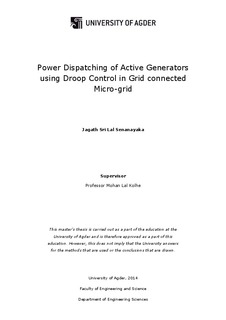| dc.description.abstract | Renewable energy promises a green energy future for the world. However, many technical problems still have to be solved. Almost all renewable energy sources require power electronic converters for power processing and therefore inverter control systems and power dispatching strategies are significant in renewable energy applications. The existing electricity grid architecture is based on centralized power generations while most renewable power generations are distributed and connected to lower or medium voltage networks. Some of important renewable energy resources such as solar and wind power are intermittent in nature. This is a challenging issue for grid integration of renewable energy into the grid and raises difficulties for power system operational control and maintaining power quality. In practical integration of renewable energy systems, these problems must be addressed and solved. In this research, grid integration methods and inverter control methods for the renewable resources have been studied. First task of the study was development of a Voltage source Converter (VSC) system. Active and reactive power control systems for power dispatching have been implemented in the VSC and so that it can work as an active generator. The power dispatching policy of the active generator is based on combination of droop and PI control method. A micro-grid model has been proposed in order to achieve high penetration of renewable energy. In the proposed 500 kW micro-grid system, it is considered that 250 kW of the power is come from the central grid and the remaining power is provided by local distributed generations. Micro-grid has been connected to the main grid via back-to-back converter topology. Frequency droop is originated from the back-to-back converter, where any power deviation from base power level (250 kW), causes ± 0.002 Hz/kW deviation from base 50 Hz frequency. In this micro-grid, there is a combination of dispatchable generations and an intermittent power generation. Dispatchable generation include a solid oxide fuel cell (SOFC) and a central energy storage system where both systems can work as active generators. Active power flow of each DG unit is based on frequency variation originated by the back-to-back converter and reactive power flow is based on the voltage variation of coupling points of each active generators. In the propose control system, power flow of local micro-grid renewable power sources are controlled for maximum utilization of available power within the micro-grid and minimize the power flow from the main-grid. In this implementation, the main-grid and micro-grid can work as two different AC power system areas where frequency and voltage are isolated through an intermediate DC path. The model has been simulated in Matlab Simulink and stable operations have been observed where micro-grid frequency, voltage and power quality were within acceptable ranges. This shows the usability of the proposed model for achieving high penetration of renewable power into micro-grids. Key words: Distributed generation (DG), Droop control, Active generators, Voltage source converters (VSC), Micro-grid, Renewable energy, Grid integration | nb_NO |
